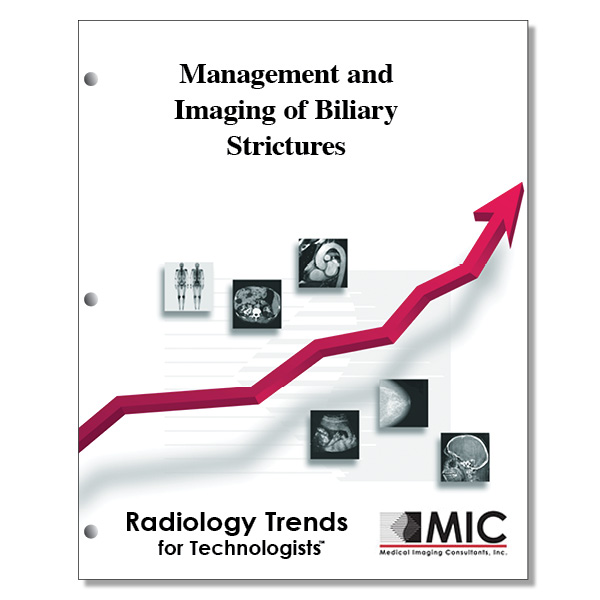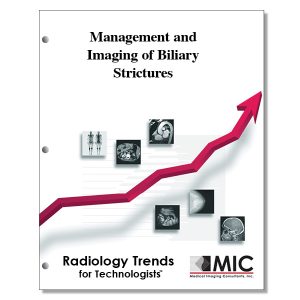

Management and Imaging of Biliary Strictures
A review of the current state of technology in the diagnosis and treatment of biliary strictures.
Course ID: Q00591 Category: Radiology Trends for Technologists Modalities: CT, MRI, Sonography, Vascular Interventional2.75 |
Satisfaction Guarantee |
$29.00
- Targeted CE
- Outline
- Objectives
Targeted CE per ARRT’s Discipline, Category, and Subcategory classification for enrollments starting after January 27, 2023:
[Note: Discipline-specific Targeted CE credits may be less than the total Category A credits approved for this course.]
Computed Tomography: 1.75
Procedures: 1.75
Abdomen and Pelvis: 1.75
Magnetic Resonance Imaging: 1.00
Procedures: 1.00
Body: 1.00
Registered Radiologist Assistant: 2.75
Procedures: 2.75
Abdominal Section: 2.75
Sonography: 1.00
Procedures: 1.00
Abdomen: 1.00
Vascular-Interventional Radiography: 2.75
Procedures: 2.75
Nonvascular Procedures: 2.75
Outline
- Introduction
- Etiology
- Classifications
- Clinical Presentation
- Imaging Diagnosis of Biliary Strictures
- Percutaneous Transhepatic Cholangiography
- Management of BBSs
- Balloon Dilation
- Maintained Large-Bore Catheter
- Stent Placement
- Management of MBSs
- Medical and Surgical Options
- Preoperative Biliary Drainage
- Success and Route of Biliary Drainage
- Complications of Biliary Drainage
- Stent Placement
- Complications of Metal Stents for MBS
- Investigational Strategies
Objectives
Upon completion of this course, students will:
- identify treatment techniques for benign biliary strictures
- identify the main goals to management of biliary strictures
- discuss reasons for reintervention after stent placement for MBSs
- identify iatrogenic causes of benign biliary strictures
- describe extrinsic causes of malignant biliary strictures
- identify commonalities between the biliary stricture classification systems
- describe the clinical symptoms of malignant biliary obstruction of the distal bile duct
- identify factors which limit ultrasound in the detection of biliary strictures
- describe the imaging features of malignant biliary strictures on CT
- describe the imaging features of benign biliary strictures on MRCP
- discuss imaging modalities used to detect biliary obstructions
- identify access areas which are commonly used by interventional radiologists
- discuss the complications of PTHC
- identify appropriate biliary duct access points for PTHC and biliary drainage
- describe appropriate management of bilioenteric anastomotic strictures
- identify treatment options for benign biliary strictures which do not respond to standard balloon dilation
- describe the advantages of covered self-expanding stents in the treatment of benign biliary strictures
- identify advantages of biodegradable stents in the treatment of benign biliary strictures
- identify patients who would benefit from minimally invasive palliative decompressive therapy and medical treatment of malignant biliary strictures
- discuss the use of preoperative biliary drainage in patients with infectious cholangitis
- compare the indications of percutaneous transhepatic biliary drainage (PTBD) to endoscopic biliary drainage
- identify the common source of bleeding after PTBD
- describe the clinical signs of arterial injury during or after PTBD
- discuss the cause of electrolyte imbalances in patients with external biliary catheter drainage
- identify the goals of palliative stent placement in patients with malignant biliary strictures
- identify the common causes of inoperable malignant biliary obstruction
- discuss imaging modalities used to image obstructed biliary ducts prior to stent placement
- identify the reasons to leave an internal-external biliary drain after self-expanding metal stent placement
- select the preferred stent for treatment of hilar obstruction
- describe modifications made to covered self-expanding metal stents to reduce stent migration
- discuss techniques for reducing cholangitis after stent placement
- identify the complication of contrast injection into the pancreatic duct
- describe the causes of acute cholecystitis after stent placement
- discuss the causes of acute recurrent obstruction after stent placement
- identify strategies currently under investigation for treatment of malignant biliary strictures
